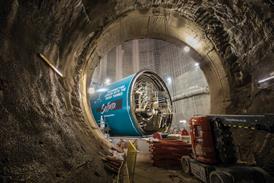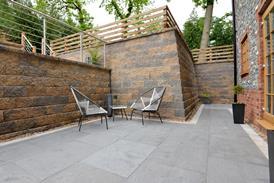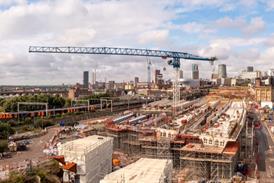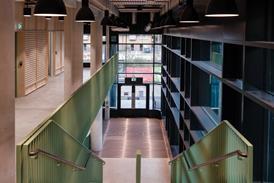Over the next six months big names in construction will be trying out the Value Toolkit on live projects, Ron Lang explains why it’s important

At a webinar hosted by ����Ӱ�� last week, I was privileged to announce , as we gave early implementers a chance to pilot this new approach that will drive better social, environmental, and economic outcomes from investment in the built environment.
Now, some of you reading this may be rolling your eyes at the use of words like ‘landmark’ or even ‘toolkit’ After all, isn’t our sector already awash with a plethora of tools and toolkits? Do we really need another one? We’ve certainly seen many noteworthy initiatives in recent years to drive much-needed change across a host of areas, from reducing our carbon footprint to modernising building methods, to how we deal with mental health.
Whatever name is used – toolkit, framework, platform - each of these initiatives has helped to drive change in their own way. Above all, however, they reflect a growing collective desire to do things differently as we face the increasingly complex challenges created by a post-pandemic world and the economic shockwaves it has wrought.
That’s what this toolkit does, and that’s why this is truly a landmark moment. Directly supporting key policy objectives common to both the government’s Construction Playbook and the CLC Roadmap to Recovery, the Value Toolkit will allow policymakers and clients to make informed decisions at every stage of the project or programme lifecycle.
Cheap and fast, in other words, does not equate to long-term benefits for the all-important end users
Getting to grips with the seemingly innocuous issue of value continues to elude our sector. Every £1 spent on construction creates an average of £2.92 of value for the economy overall. On the face of it, and particularly in times of economic woe, this might seem like a fairly good deal. But, take a closer look and you’ll quickly realise that this ‘average’ disguises significant variations in performance.
A new school building for instance, may be delivered on time and on budget, but may still fail to deliver the intended outcomes. Cheap and fast, in other words, does not equate to long-term benefits for the all-important end users (in this case, teachers, students) and for wider society. There is a rapidly growing consensus across the construction sector and government that we cannot continue in the mindset of yesterday. The practices which have dominated for so long are simply not sustainable – either from an environmental, social or economic perspective. As the pandemic, and the challenges it has created, have shown, we must deliver projects today that are equal to the challenges of tomorrow.
A novel solution to a familiar problem
Attempting to tackle the sector’s value conundrum is by no means novel, but the approach we’ve taken in creating the Value Toolkit undoubtedly is. Despite the unique blend of expertise which exists within the Construction Innovation Hub, we recognised very early on in the development of the Toolkit that this is not something that could be developed behind closed doors.
The toolkit is a truly ground-up initiative, building on the solid foundations laid by Ann Bentley and the CLC over many years. Bringing together more than 150 voices from across government and industry, including ACE, IPA, CLC, CIOB, RIBA, RICS, Social Value UK and UKGBC.
The toolkit is an exemplar of what the collaborative spirit can truly achieve. It is the embodiment of our sector’s ingenuity, its innovation potential and, above all, its collective desire to do things better.
But you don’t need to take my word for it. The reason we are launching the test phase of the toolkit is to give practitioners – industry and government – a chance to take the new process and tools for a test-drive to experience, first-hand, the delivery of projects and programmes. Already, 30 early implementers have signed up to be part of the pilot phase, including Arup, Mace, Mott MacDonald and Morgan Sindall, which will see the Value Toolkit deployed on live projects and programmes over the next six months.
At the outset of any given investment in the built environment, the toolkit will help steer clients and firms towards the right decisions to shape the outcomes they wish to achieve. Crucially, these outcomes will not be limited solely to the delivery stage of the project, but rather the whole-life of the asset, including how it contributes to the local community, enhances the wellbeing of its users and affects the environment. A school, hospital or home built today, must meet the challenges of tomorrow - some of which we know, and others we don’t.
To truly know if a project is delivering on its intended outcomes, we must be able to measure them. The toolkit will allow clients and construction firms to consistently measure the whole-life performance of a building, from design phase to construction phase, to how it is performing when it is occupied and serving its intended purpose. Crucially, the Value Toolkit encourages the creation of a data feedback loop; what we learn from projects and programmes today will ensure better outcomes on the build projects of tomorrow.
Getting it right first time
Over the next six months, we will be rigorously road-test the Value Toolkit. We’ll be fine-tuning and perfecting the process and tools to ensure they meet the needs of policymakers and businesses, large and small.
We’re not simply ‘kicking the tyres’; we are determined to avoid the Toolkit becoming the latest in a long line of initiatives which is initially well received and then quickly fades into the background. To invert a well-known cliché, the Value Toolkit will very much be a ‘one size fits all’, allowing a consistent approach to value-based decisions, whatever the nature of the project.
As evidenced by the massive outpouring of support and enthusiasm we’ve received on this journey, the will to do things better is very much there. In collaborating to create the Value Toolkit, we are developing and showing the way.
Ron Lang is impact director for value at the Construction Innovation Hub



























No comments yet